Peperomia Ruby cascade is a cascading vine belonging to the pepper family Piperaceae, native to South America and Central America, especially Ecuador and Peru.
It has downward trailing or cascading reddish vines, and succulent glossy, dark green leaves with a ruby or reddish-pink underside, especially as they mature.
Kindly, don’t confuse it with Ruby Glow, scientifically known as Peperomia graveolens ‘Ruby Glow’. Ruby glow grows upright, has wine-red stems, canoe-shaped, succulent, glossy reddish leaves with a green upper surface. See the photo below.
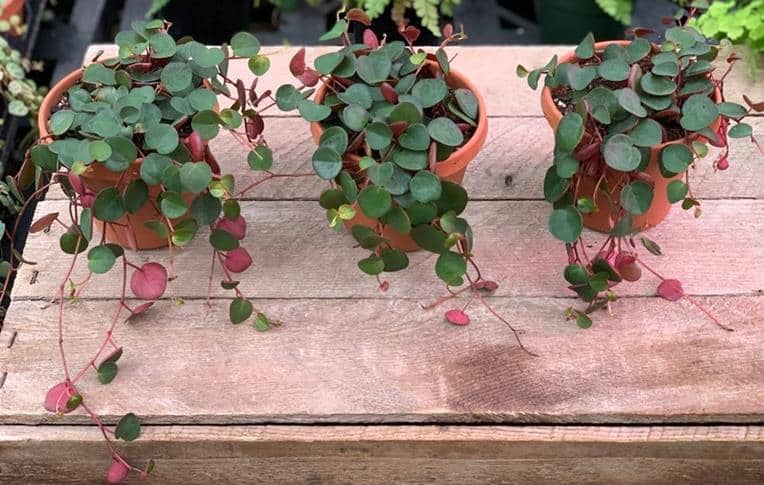
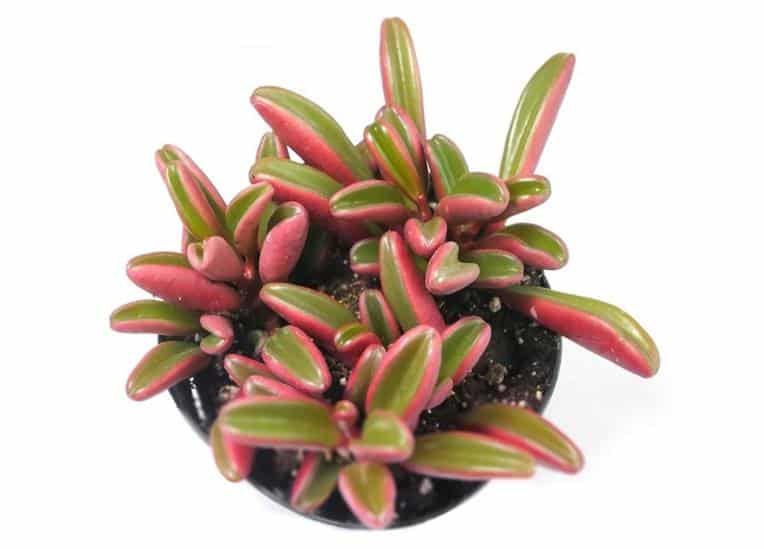
Contents
- Quick overview
- Appearance and identification
- 1. Size
- 2. Leaves
- 3. Stems/vines
- 4. Flowers
- Variegated peperomia ruby cascade
- Peperomia Ruby cascade care and growing conditions
- 1. USDA hardiness zone
- 2. Temperature
- 3. Humidity
- 4. Light
- 5. Soil
- 6. Watering
- i). How to water them
- ii. Overwatered peperomia ruby cascade
- ii. Underwatered
- 7. Fertilizer
- 8. Pruning
- 9. Repotting
- How to propagate peperomia ruby cascade
- i. What do you need?
- ii. Steps to follow
- iv. What to expect?
- Safety for pets and kids
- Disease and conditions
- a). Leaves yellowing
- b). Wilting
- c). Dropping leaves
- Pests
- Peperomia pepperspot vs. ruby cascade vs. string of turtles
- a). Peperomia pepperspot
- b). String of turtle (Peperomia prostrata)
Quick overview
| Scientific name | Peperomia Ruby cascade |
| Family | Piperaceae (pepper family) |
| Common names | Ruby cascade peperomia, ruby cascade |
| Native habitat | South America and Central America (not well documented) |
| Type | Evergreen, flowering perennial vine (epiphyte) |
| Size | Small, 2-4 inches in height with vines growing several feet tall |
| Leaves | Almost round, dark green fleshy, leaves with a pinkish-red underside |
| Flowers | Inconspicuous, tiny greenish flowers growing on long spiky stalks |
| Stems | Pinkish-red |
| Blooming time | Throughout after it matures |
| Light requirement | Prefers bright, indirect light |
| USDA hardiness zone | 9b to 11 |
| Temperature | from 65°F to 80°F, can’t withstand frost conditions |
| Humidity | Moderate to high |
| Growth rate | Moderate to fast-growing |
| Soil | Well-drained, slightly acid potting mix that is high in organic matter. |
| Watering | Infrequent watering, allowing the soil to slightly dry |
| Propagation | Stem cutting |
| Toxicity | Not toxic or poisonous to humans, dogs, cats, and other pets |
| Care level | Easy or beginner |
Appearance and identification
We must confess that the peperomia ruby cascade is one of the most misrepresented plants since it has scanty information. Here is how to identify it:

1. Size
Initially, the peperomia ruby cascade is small, measuring about 2 to 4 inches, and it grows at a slower rate.
However, as soon as it begins growing cascading vines, it proliferates quickly and may grow several feet long if given the right growing conditions.
Therefore, you need to provide sufficient space for vines to cascade as they can grow very long within no time.
2. Leaves
Besides the cascading vines, what makes plants the most appealing is the leaf color.
The peperomia ruby cascade has nearly round, succulent leaves with a glossy, dark green color on the upper side, while the underside is reddish pink.
These leaves have a pinkish-red petiole and look fragile. Therefore, you need to carefully handle the plant, especially when potting it, to avoid injury.
3. Stems/vines
Like petiole, the stems are reddish-pink. They are relatively thin and grow leaves on alternatively opposite sides.
4. Flowers
Ruby peperomia produces greenish, tiny inconspicuous flowers with a long slender stalk. Usually, the flowers begin showing when it matures and have reasonably long vines.
Kindly note that this plant doesn’t have ‘small round pink flowers’ or ‘funnel-shaped reddish flowers,’ as I said from several sources online.
Below is a video to tell you more about this adorable, easy-care houseplant
Variegated peperomia ruby cascade
Yes, we did find a lightly variegated peperomia ruby cascade at Etsy.com. Every other feature about this plant is the same as the non-variegated.
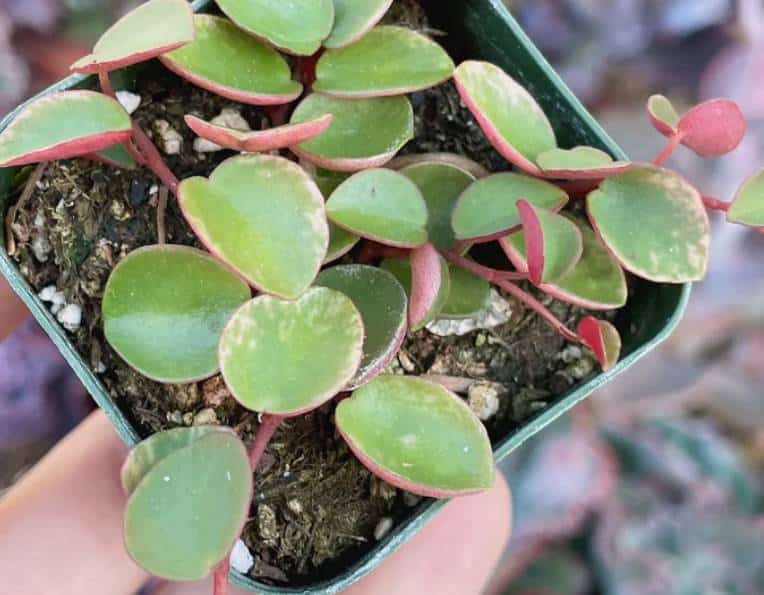
However, it does have minor, cream-white marking on the upper side of the leaves. The rest of the care needs are the same.
Peperomia Ruby cascade care and growing conditions
Peperomia ruby cascade is easy to care for, adorably looking vining houseplant. However, it does require a little more lighting compared to other radiator plants to grow optimally.
Also, it is fragile (handle with care) and doesn’t tolerate extreme temperatures, i.e., very low or high.
Here is how to care for this plant and growing conditions, including USDA zone, temperature, humidity, watering, propagation, and much more.
1. USDA hardiness zone
Peperomia ruby cascade USDA hardiness zone is 9b to 11. If you grow these plants outdoors, return them indoors if the winter temperature is less than 50 degrees Fahrenheit (10°C). They are not frost-hardy and may die in such low temperatures.
2. Temperature
These peperomias are endemic to tropical and subtropical places where temperatures are neither extremely cold nor hot, moderately warm. This range is what they require.
Peperomia ruby cascade prefers temperatures ranging from 65 to 80 degrees Fahrenheit (18.3 to 26.7 °C).
Cold winters or temperatures below 50 degrees Fahrenheit (10°C) may harm your peperomias plant. Therefore, if you are growing it outdoors, move it indoors.
Similarly, avoid too high temperatures, especially summers (they don’t like hot weather, it will kill them), or enormous temperature swings as they may injure this adorable plant.
Finally, to help maintain a constant temperature, ensure you don’t put these plants near air conditioning or room heating vents.
3. Humidity
Unlike true succulents that thrive with very low humidity and water, your peperomia ruby cascade prefers moderate to high humidity, just as in their natural habitat. They can tolerate even up to 90% relative humidity.
However, they can still thrive in average household humidity if it doesn’t go too low, i.e., below 40%. Otherwise, expect brown leaf edges, wilting, yellowing of leaves, and dry, crispy-looking foliage.
Why does this happen? The answer is simple. When the humidity goes too low, the plants’ foliage will lose lots of moisture and start drying. Even the potting mix will dry faster, meaning more watering. However, ensure you don’t overwater.
To help boost indoor humidity, have a pebble tray, mist your peperomia from time to time or have a humidifier. AquaOasis™ Cool Mist Humidifier is a great brand. It is rated highest on Amazon, will run for up to 24 hours, and is affordable. However, you can still buy other brands like LEVOIT or Pure Enrichment® MistAire™. Just ensure they are cool mist.
Also, closely monitor humidity during winter because air will hold less moisture, and humidity will drop as temperature drops.
4. Light
Yes, these are tropical plants. However, they receive mainly filtered sunlight from tall tree canopies in their natural habitat.
That said, if you are growing them indoors, provide peperomia ruby cascade with indirect bright light for best coloration and growth. However, they can adapt to indirect medium light but may not look as vibrant or grow slower if it is too low.
Kindly avoid placing these plants in direct hot sunlight as it will scorch their leaves. You may notice some foliage discoloration (becomes paler) or may have a brownish, dry, crispy edge.
People growing ruby cascade peperomia outdoors need spots with filtered sunlight (somewhere with a partial shade). Alternatively, you can 30 to 40% shade clothes or have a greenhouse.
Finally, if your plants don’t have enough light, get a grow light and give them an illumination of about 12 hours.
5. Soil
While in their natural habitat, these epiphytes derive their nutrients from the air, moisture, and rotting debris leaves, bark, or debris. They don’t grow roots in the ground. Therefore, they are not so fussy about the soil you give them as long as it is well-drained and high in organic matter.
Usually, ruby cascade peperomia require well-aerated, well-drained, nutrient-rich, or high organic matter soil or potting mix (soil-less). Also, they prefer slightly acid pH (6.0-6.6) but can tolerate neutral or slightly alkaline conditions.
An ideal choice for these plants is a 50/50 mix of perlite and peat moss. Pumice or coarse sand can replace perlite.
Perlite will ensure the potting mix is well-drained while peat moss is rich in organic matter, making it nutrient-rich. Also, it will help retain moisture.
Besides perlite/moss mix, you can opt for loamy or sandy soils. However, ensure they are well-drained and add some organic matter. Some coconut coir or bark mulch will improve draining and provide organic matter.
That is not all. Regular potting soils, topsoil, or garden soils don’t have enough organic matter to provide the required nutrients. Also, they may have clay to prevent proper draining. Remember that these plants are sensitive to overwatering and soggy soil as it will cause root rot.
If you don't like going through the trouble of making a perfect soil mix, why not go for Miracle-Gro Indoor Potting Mix? It will not have gnats (it has any bark chips) and feeds your plant for up to six months.
6. Watering
Although they have fleshy leaves, these plants require slightly more water than succulents. However, they don’t need too much since they can store some for a while. Water when the top 50%-75% of the soil is dry.
These plants are vulnerable to root rot if overwatered. But again, too little water will affect your plant. Therefore, you need to give them the right amount.
i). How to water them
So, how should you water them? The answer is simple. Peperomia ruby cascade requires infrequent deep watering allowing the soil to slightly dry in-between each session, i.e., soak and dry watering method.
To water these plants, you need to soak the soil around this houseplant slowly until water begins flowing from the drainage holes. Discard any that remains on the saucer beneath your pot.
Afterward, please wait until the top 50% of the soil is dry or about 2 inches before watering them again.
To know its watering time, fill the soil. If it feels dry up to the knuckle of your finger, your plant needs water. If not, wait for a couple of days before testing again.
If you don't like touching soil, go for a soil moisture meter. XLUX is the best pick. Water if the soil reads three or less. You can also buy Goevn. It's good too.
Alternatively, look at the leaves. If they look plump, thick, bloated, and rigid, your plant doesn’t need watering. However, if they are thin and a little flabby, it is time to water.
How often to water your ruby cascade peperomia depends on season, light, humidity, temperature, etc. Typically, this takes 7 to 10 days. However, to be on the safe side, check the moisture level in your potting mix.
ii. Overwatered peperomia ruby cascade
The telltale signs that you have overwatered your peperomia include the following:
- Soggy or always moisty and wet potting mix.
- Yellowing or browning of older and young leaves
- Foliage dropping
- Mushy feel around the plant base
- Fungus on potting mix
- Other signs of root rot
ii. Underwatered
To know if your plant is thirsty, look at any of these signs:
- Parched soil
- Leaf curling
- Dry brown leaf tips and edges or yellowing of lower leaves
- Wilting
- Stunted growth
- Leaf dropping
If you notice any sides with dry soil, consider increasing the watering frequency without overdoing it.
7. Fertilizer
These plants don’t require a lot of fertilizer. Nevertheless, they will benefit from plant food, especially if you don’t have a potting mix rich in organic matter.
Therefore, feed your ruby cascade peperomia with an all-purpose liquid fertilizer for potted or indoor plants at half recommended strength after every other week during spring and summer (growing seasons).
We use Bonide Liquid Plant Food 10-10-10 and feed ⅛ a teaspoon per two quarts of water, i.e., half dilution every month. We have also tried Miracle-Gro Indoor Plant Food Spikes for our Watermelon Peperomia, which seems to be just as fine. The good thing with this slow-release formula is that you only apply it once in two months.
However, please don’t feed them during winter or fall as they will be dormant, i.e., they are not growing and won’t use the fertilizer. Instead, it will remain in the soil and may affect the roots.
Finally, while inadequate nutrients may cause leaves yellowing and stunted growth, ensure you don’t overdo it. Too much fertilizer may result in dry or burnt leaf margins, stunted growth, wilting, leaf yellowing, etcetera.
8. Pruning
Since it doesn’t spread much, the ruby cascade doesn’t require much pruning. All you have to do is remove any dead, old brown, or dry leaves.
However, as it grows, it will begin having very long cascading vines, pruning may be necessary if you have a small place. In such a case, you may consider cutting some of the long or unruly vines to keep your plant looking smaller and compact.
Always prune this plant when its dormancy period is almost ending, i.e., late autumn/fall. It will encourage more growth when spring sets in.
However, don’t excessively prune this plant as it may affect its growth and overall health, and use sterilized pruning scissors or shears.
9. Repotting
Ruby cascade plants have shallow, small roots, making frequent repotting unnecessary. Also, these roots are thin roots very fragile, and the process causes a lot of stress.
Therefore, only repot peperomia ruby cascade when they are root bound or after two to three years.
Dull or leggy plants, stunted growth, yellowing leaves, or foliage falling may not always require repotting. It may be nutrients or other problems. Conduct an investigation.
However, if you notice roots growing from drainage holes and sliding your plant out, you see they are tightly packed and curly at the bottom, then it is time to change it to a larger pot.
Also, since they are relatively fast-growing, especially as the vines begin cascading, repot if they came in a tiny pot or planter.
When repotting, pick a pot 2-3 inches larger in diameter and deep enough to accommodate the roots, leaving room for more growth. Avoid too large as they increase overwatering risks.
Finally, always repot plants during spring when the plant is actively growing. Also, be very careful not to injure their fragile leaves or roots.
How to propagate peperomia ruby cascade
Peperomia ruby cascade propagation is by stem cutting, leaf, or division. All these three methods are easy. Also, you can propagate them by laying the long cascading vines on moist rooting media or soil, and they will begin rooting.
Whichever method you go for, the best time to propagate these plants is in early spring, when they start growing after a cold season.
You are free to use water or potting mix. However, if you use water, ensure you cover your transparent jar to prevent algae growth.
We will look at propagation by stem cutting. It is the easiest and will guarantee you lots of success. Using water is not also hard.
i. What do you need?
- Clean, sharp scissors or knife
- A stick,
- Growing pot or water jar
- Potting mix or water
- A rooting hormone (optional).
ii. Steps to follow
Step 1: Start by putting your soilless mix (50/50 perlite and moss peat) and then dampen it.
Step 2: Next, select a healthy-looking stem about 5 to 6 inches long with a few leaves at cut it at 45 degrees angle (maximizes area for rooting) with your scissor or sharp knife. Your cutting point should be closest to the leaf or stem before your cutting point.
Step 3: Thirdly, remove the lower leaves, leaving about three or four, and let it callus for a few hours to help heal the cutting wound, being a semi-succulent plant. Doing so will reduce rotting and bacterial infection.
Step 4: Once your stem callus, dip it in your rooting hormone. Not mandatory but will speed up the rooting process and ensure no rotting happens. We love HydroDynamics Clonex Rooting Gel. It has a water-based formulation that will provide vitamins and hormones necessary for quicker rooting. Garden Safe Brand TakeRoo is also good.
Step 5: Poke a small hole into your potting mix using a small stick, carefully place your cutting and tamp the soil to hold your cutting firmly. Ensure at least two growth nodes (where you removed leaves).
Step 6: Place your cutting in indirect, bright light. For best results, maintain a 70 to 75 degrees Fahrenheit (21 to 23.8°C) temperature. Also, routinely check the growth media to ensure it remains with some moisture and water as necessary. Don’t make overwater it as it may promote rot.
iv. What to expect?
After a month or two, roots and a new bud will begin growing. Once it produces a leaf, you can transplant it to a growing pot. Just scoop it with a trowel.
Pro tip: If you decide to grow it in water, give it a little while for roots to properly form before transplanting it. Usually, propagation done in water produces very fragile roots, and there is no soil to scoop with when transferring it to a growing pot.
Safety for pets and kids
Is peperomia ruby cascade safe for your cats, dogs, or children? The answer is yes. It is not toxic or poisonous to humans, dogs, cats, and other pets.
Therefore, it is an excellent vine choice for people who have pets, unlike philodendrons and pothos, which are toxic (have insoluble calcium oxalates).
Disease and conditions
Ruby cascade peperomia houseplants are not susceptible to fungal, bacterial, or viral disease. Incidents may occur if you use a potting mix with any of these pathogens.
Besides diseases, some of the common conditions include:
a). Leaves yellowing
The most common cause of ruby cascade peperomia leave yellowing is overwatering. However, nutritional deficiencies, underwatering, too much or too little light, pests, or diseases may be reasons.
b). Wilting
If you see this plant wilting, it may indicate it is thirsty. Other possible causes are overwatering (if it causes root rot), pests, disease, low humidity, or extremely high temperature.
c). Dropping leaves
If your plant has droopy leaves, it is either under too much direct light (may also turn pale or yellowish), has little water, or you have overwatered it.
Pests
If you grow them indoors and care for them well, these plants may not have any pests. Nevertheless, the common pets they have included the following:
- Spider mites
- Mealybugs
- Scale
- Fungus gnats
- Thrips
Depending on which specific bugs you may opt for, pruning, insecticidal soaps, neem oil, hosing the affected plant, among other strategies.
Peperomia pepperspot vs. ruby cascade vs. string of turtles
While they don’t resemble each other so much, especially the string of turtle, they are both vining peperomia. You already know ruby cascade. Let us look at the other two.
a). Peperomia pepperspot
Peperomia pepperspot has small, round, glossy emerald-colored succulent leaves with a brownish-red underside, vines, and petiole. The leaves are about the size of a coin and have
This peperomia vine is heavily intertwined and appears as a bushy heap. Also, unlike ruby cascade, and their underside or vines are not ruby-colored.
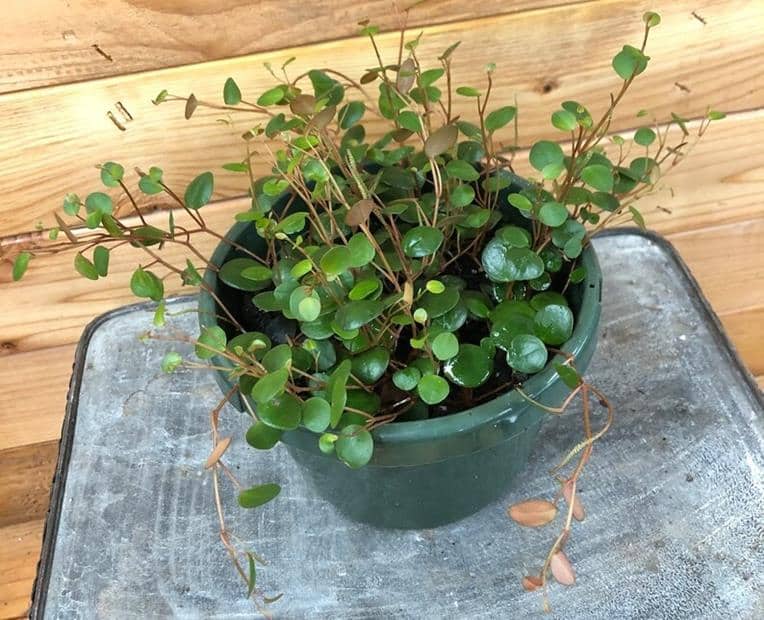
b). String of turtle (Peperomia prostrata)
The string of turtles, scientifically known as Peperomia prostrata, is a trailing peperomia vine with small round leaves with a delicate pattern of contrasting dark and light green color that resembles a miniature shell of a turtle.

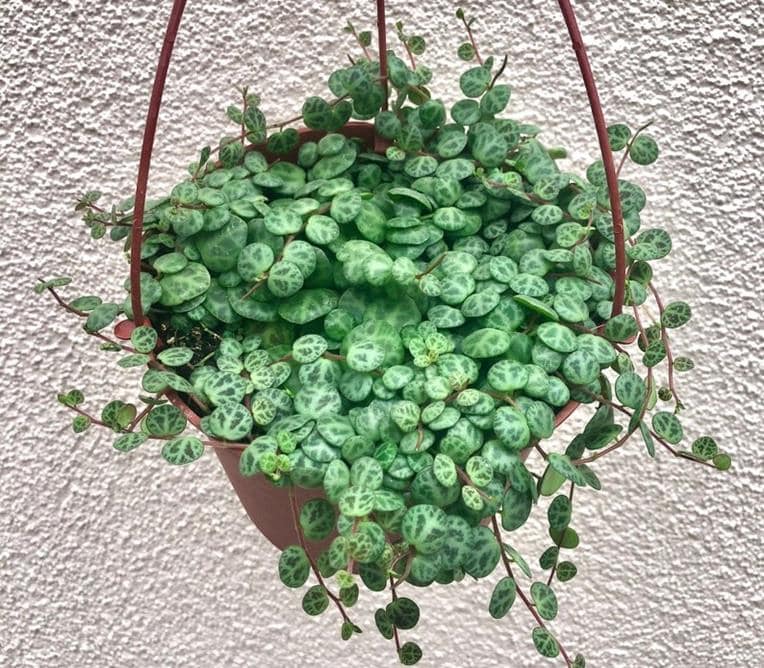




Leave a Reply